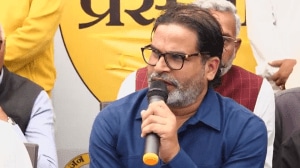In Gadchirolis red zone
The Naxal assault on October 8 that killed 17 policemen is the most recent in Gadchiroli,which is caught in a spiral of violence.
The Naxal assault on October 8 that killed 17 policemen is the most recent in Gadchiroli,which is caught in a spiral of violence. THE Indian EXPRESS travels to the tribal district of Maharashtra that has become one of the major Maoist battlegrounds
With the Pranhita,Godavari and Indravati flowing through its lush landscape,its exquisitely carved ninth-century temples of Markanda,and the thickly-wooded Chaprala sanctuary,Gadchiroli is a land of beauty and serenity. But over the last few months,Gadchiroli,in eastern Maharashtra,has been caught in a vortex of Maoist violence.
Small huts dot the tarred roads that go right through its interiors,roads that have been built despite violent opposition from Maoists. Mainly inhabited by Madia-Gond tribals,other tribes like the Pradhans and the Kolams,and displaced Bengali refugees who form over half of its over 13-lakh population,there is little here to suggest that these villages are at the centre of a storm. But there is no missing the curious,shy and often probing glances you get from the villagers. It may look calm and sleepy,but Gadchiroli is always in a state of high alert. And everyone knows why.
Nearly 30 years ago,Gadchiroli was influenced by Naxal ideology that came in from neighbouring Andhra Pradesh. The ideology soon turned into a wave of terror. And now,as the decisive battle between the Maoist insurgents and the state becomes intense,Gadchiroli is the battleground.
In recent months,Gadchiroli has gone from becoming a relatively less-affected Maoist spot in the Red Corridor to one of the main combat zones between the state and Maoist insurgents. In the past 10 months,Maoist attacks have gone up in the region. On October 8,the Naxals ambushed a police patrol,killing 17 policemen. About 53 policemen and 30 civilians have been killed in four big attacks this year. In the last 28 years,113 security personnel and 367 civilians have been killed here.
From the southernmost tip of Ankisa,in Sironcha tehsil bordering Andhras Karimnagar district,to the northern tip of Maseli,close to Chhattisgarhs Durg district,Gadchiroli today is caught between red terror and khaki vigil. Outwardly,everybody looks very good. They all talk about good things. But it is difficult to guess who is up to what. Its all very suspicious here, says Bajirao Halami,father of Suresh Halami who was killed by Naxals in Irup Dhodri on the night of October 7. The Naxals tied his legs and hands,slit his throat and left him to die a painful death.
Suresh was killed because the Naxals believed he was a police informer. Bajirao says his son was returning from his field on April 26,2007,when a police party spotted Naxals near the village. The Naxals thought he had informed the police. The police took him away to Gadchiroli town and gave him a place to stay and food to eat. But when he came to the village recently,Naxals got to know and killed him, says Bajirao. You never know who is spying on you, he says.
In an environment where mutual suspicion flourishes,its difficult to tell whos with whom. Unlike in Andhra Pradesh,where the feudal exploitation of the landless gave Naxalism a perfect launch pad,in Gadchiroli,the tribals own their agricultural land. So,the Naxals had little cause to fight for except to stop the exploitation of tendu-pluckers and bamboo workers. They did it in the early 80s,winning tribal hearts,but their continued presence,ironically,brought more policemen,and obviously,more trouble,to the district.
It has become a vicious cycle, says tribal activist Paromita Goswami. Maoists cant refute the fact that they owe the existence of such a large police presence to themselves, says the activist who has taken the police to court for the death of Chinna Mattami,a tribal youth. Mattami was killed in a police encounter in 2002. Paromita has won many battles with the administration to restore to tribals their rightful claim to land and other resources and to get them their share from government schemes.
In the Red Corridor,Gadchiroli has the distinction of having a battery of social workers who have given marginalised tribals non-violent alternatives to the Maoist power-from-the-barrel-of-the-gun solution. Tribal hospitals run by Baba Amtes doctor-son Prakash and wife Manda at Bhamragarh in the south,health activists and researchers Abhay and Rani Bang at Shodhgram in the north and Satish Gogulwars health organisation Amhi Amchya Arogyasathi,are all working in this tribal heartland,drawing curious visitors and students from all over the world.
In the past 36 years,the Amtes have packaged a gamut of development initiatives that produced the regions first tribal doctor,Kanna Madavi,in 1993 and state track-and-field champions like Durjan Madavi and Bhimrao Gawde. Gadchirolis 12,000 sq km of forest has virtually been cleared of wildlife,but Amtes animal ark has rekindled ecological awareness among tribals who bring orphaned wild cubs to him rather than killing them for food.
The Bang couples barefoot doctorslocally trained health workershave brought down child mortality in the villages where they work. Their socio-medical research has caught the attention not only of world-famous medical journals,but also of governments in Africa and Asia whose teams come regularly to receive training in the methods developed by the Bangss Shodhgram.
Mohan Hirabai Hiralals self-governance model in Mendha-Lekha village in the troubled Dhanora tehsil provides a strong,viable alternative to the so-called armed revolution against the state. Here,villagers led by the unlettered Devaji Tofa implement their own ideas of development. It is the first village to record its bio-diversity and use a little-known provision of the Tribal Act to get community rights over the forests around it.
The government has the responsibility of implementing sustainable,people-oriented developmental plans, says Mohan.
Gadchirolis problems are varied. With vast areas under forests,there is not much industrial activity in the district. Barring the Thapar Groups paper mill at Ashti,there is no other factory here. It has a vast potential for bamboo-based units but that has gone unrealised. Then there is the Naxal threat. Industries cant survive in Gadchiroli without Naxal consent,which means doling out huge haftas, says a senior official of a leading firm.
Despite the Border Roads Organisation (BRO) working in the area,many bridges and roads are left incomplete because the Naxals wont let work progress. Three years ago,Naxals killed BRO engineer N. Genesan for refusing to stop work. The Naxals are also accused of obstructing works under the employment guarantee scheme.
The Naxals have been saying that they are fighting to bring us power. For many years,we roamed the forests chasing this elusive dream,but it was nowhere in sight. So,we decided to surrender, says Sukhlal Atla and his wife Renuka,both Naxals who surrendered last year.
Suresh Harami,former member of the North Gadchiroli-Gondia Divisional Committee who laid down arms early this year,says,I often fought with them (Naxal bosses),arguing that we should allow some development works like roads since they are really needed,especially in times of health emergencies. They never agreed.
Recently,however,a group of remote villages in Sironcha prevailed upon the Naxals to let the BRO build a bridge near Parsewada in Sironcha. The bridge is now complete,connecting 20 villages to the outside world.
In the absence of other employment opportunities,the only jobs available to the youth of Gadchiroli are in the police department. They throng the recruitment grounds in thousands,even if it means courting Naxal ire. Those who cant get in become police informers instead,often meeting a violent end. Still others join the Naxal army. Those who choose not to join any of them are left to live in misery.
Tribals hesitate to say it but they are tired of their forced segregation from the mainstream. The first priority should be to solve the unemployment problem. Government schemes are mostly only on paper. Education efforts must be hugely multiplied to bring tribals into the mainstream, says Prakash Amte.
The villagers hope their isolation will end,as also the cycle of violence.





- 01
- 02
- 03
- 04
- 05


























